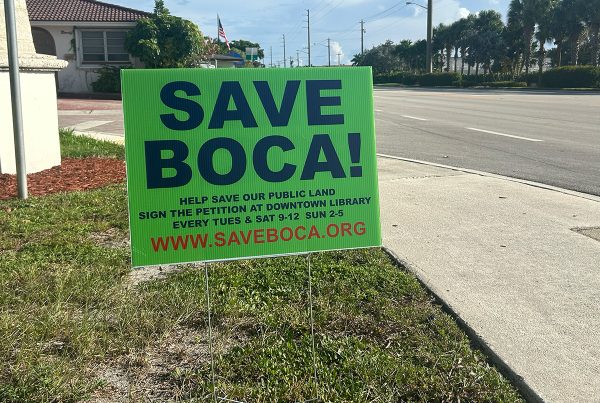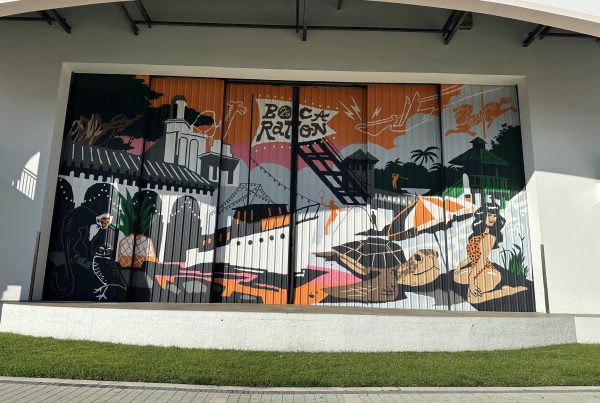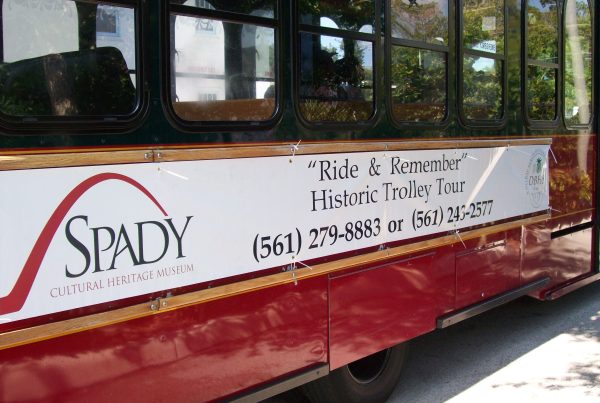For the November/December issue of Boca magazine, we caught up with four local families who shared their own spin on holiday traditions.
Written by Tyler Childress, Christiana Lilly & John Thomason
Thanksgiving
There’s one detail that Coton Stine, owner and executive chef of Costa in Delray Beach, remembers most about her childhood Thanksgivings in Boise, Idaho—the food. But growing up in a vegetarian and pescatarian family, Thanksgiving spreads looked very different than what most families are used to. “[My dad] would make a rainbow trout, and that was the main part of the Thanksgiving dinner, because we never did any birds—so no turkeys,” says Stine.
A turkey-less Thanksgiving is a tradition that Stine continues to this day with her family and shares with the community through oven-ready meals that she and her team of chefs prepare for pickup the day before Thanksgiving. Though turkey is always on Costa’s Thanksgiving menu, Stine also offers a South Florida spin on the traditional pecan and herb-crusted rainbow trout that she grew up with.
“Now I don’t do trout anymore because I’m in South Florida, so I switched to either a yellowtail or red snapper,” says Stine. “It’s the same crust, the same flavors in memory of that [dish], but it’s with a local fish.”

THE PARTICIPANTS: With much of her family still in Boise, Stine spends Thanksgiving with her husband and children, handling the cooking while the kids make name cards for the place settings at the table—a tradition that she was tasked with as a child and has now passed down. “The kids always do the name tags, and the kids always lead the Thanksgiving gratitude prayers,” says Stine.

THE TRADITION: On Thanksgiving, Stine begins the day with a quintessential tradition from her childhood. “My parents would put the Macy’s Day Parade on first thing in the morning, and I still to this day do it.” The parade plays in the background while she prepares the meal with some help from the kids.
Stine also closes Costa for the only day of the year on Thanksgiving so her staff can spend time enjoying family traditions of their own. “It’s the one day that I just decided from the beginning that I wanted to be able to have everybody not be committed to serving everyone else and be able to be with their families,” says Stine.

THE FOOD: Like the Thanksgiving meals that Stine prepares at Costa, the stars of the feast at home are a nutand herb-crusted fish and Stine’s take on the cranberry sauce dish that her mom used to make from scratch. Stine also prepares the usual suspects of Thanksgiving fare, including mashed potatoes, stuffing and green bean casserole—with as much as possible prepared with ingredients from local farmers. “Locally sourced is a big thing that I embrace, so I’ll do a green bean casserole, but I use my Gratitude Farms mushrooms,” says Stine.
THE WHY: “Thanksgiving was just a really memorable family time for me growing up,” says Stine. “It resonates with the heart, knowing those feelings that felt good for me as a child growing up and then as an adult having my children and sharing that with them.”
Hanukkah

Hanukkah is a “very minor holiday” in Judaism, Abra Sills says, and with it being grouped in with Christmas, it can become a very gift-focused holiday. While her children still receive gifts, they have expanded the holiday to include the eight days of kindness.
THE PARTICIPANTS: Gathered around their collection of menorahs in their Boca Raton home are Abra and Jordan Sills and their children, Erev, Ber, Auryn and Ruven, who range from age 3 to 12. Abra’s 97-year-old grandmother joins the family for the first night of Hanukkah, and the couple’s parents also are included on FaceTime to watch their grandchildren light the candles.
THE TRADITION: In 2019, Abra Sills was inspired by a mom who organized 12 days of giving back for her children during Thanksgiving. She decided it would be the perfect fit for her family’s Hanukkah celebrations, but instead, she made eight envelopes with a different activity to spread kindness. “I wanted to give a little bit more meaning to the holidays,” Sills says.
Activities can range from calling a grandparent on the phone, telling a teacher what they appreciate about them, donating one of their new toys to a toy drive, or purchasing gift cards to leave on strangers’ windshields. It’s also an opportunity to teach one of the top rungs on the Jewish Ladder of Tzedakah: anonymous giving and receiving. “The disparity is huge here,” she says of the South Florida community. “I think my children are just more aware of their luck, their gratitude. … They definitely recognize that others do not have what we have.”
Sills’ family is also known for its extensive collection of menorahs, from the one her grandmother brought over from Germany in 1939 to contemporary ones she’s found at TJ Maxx. On any given Hanukkah, they may be lighting a dozen menorahs, ensuring every one gets a chance to light the candles. During a trip to Hawaii, she collected lava rocks and used their porous surface as the perfect vessel for candles. This year, she wants her family to take part in a beach cleanup and light a candle in the sand. “The menorah is a modern invention,” Sills explains. “It was like, literally, ‘pour some cups of oil and leave them out.’ And so the menorah could be anything.”
THE FOOD: While the family purchases sufganiyot (jelly doughnuts), they do make their own latkes (fried potato pancakes) and go all out with toppings. Some favorites: homemade applesauce, sour cream, truffle powder, mango chutney, fig jam, Everything Bagel seasoning and Branston Pickles. “It’s all about the condiments for our family,” she says. “The latkes are the vehicle.”
THE WHY: Sills remembers when she realized how important Hanukkah was to her; she was working on a cruise ship during the holidays, and without her family around, she organized her own celebration. She hopes that the holidays—and the eight days of kindness—will carry her children into their adulthood; that one day, they may be in their dorm rooms or standing next to their own children lighting a menorah. “For a lot of Jewish people, the hope is that the things you instill in your children are not for your children. They’re for your great-grandchildren that you may never get to meet,” she explains.
Christmas

The annual Christmas Party hosted by Boca Raton couple Conor Walton, a professional stage actor, and Mark Traverso, a marketing executive, started “small,” in relative terms, around 2010. “We probably had 75 to 100 the first year,” Walton recalls. “We were able to keep all the furniture in the house. … It wasn’t what it got built into after word of mouth started happening.” Within a year or two, the party, always held on a Sunday before Christmas, became one of the most coveted invitations of the season, and like the Grinch’s heart, it just kept growing and growing.
THE PARTICIPANTS: The party started with personal friends and family and select colleagues from the South Florida theatre community, who then raved to their own friends about it. “Then we invited our neighbors for about two blocks so they wouldn’t mind the noise and cars,” Traverso says. At its height, the party drew upwards of 400 attendees, many unknown to the hosts, which prompted them to scale it back a wee bit.
THE TRADITION: The spouses started the party because, per Walton, “I have an obsession with decorating, and we figured we might as well put it to use. … I always had to top the previous year—people can’t come in and see the same thing. That’s no fun for anybody, nor is it fun for me.”
Walton starts the process in mid-November by bringing in storage pods of decorations, mixing up the design, adding new elements each year, and hiring talent to enhance the atmosphere. A professional Mr. and Mrs. Claus are usually hired, along with a stable of elves. Other years featured stilt walkers, live Huskies with a sled, 15-foot nutcrackers lining the walkway, and a mock-up of Santa’s Workshop built by a Carbonell-winning scenic designer, which guests had to walk through to enter the house. Professional actors sing carols for the first hour or two outside, and a pianist and violinist perform inside.
THE FOOD: This is Traverso’s department, in conjunction with their partners at The Addison, which installs an outdoor kitchen for the event. “We wanted to make sure there were always appetizers, salads, sandwiches, snacks,” he says. “Then it would be the big reveal of sausages and peppers, meatballs, filets, carving stations, mashed potatoes. We got very formal as the menu grew. … After everyone would eat, we’d clear the dining room and do a dessert reveal, where we would have five or six different suppliers of doughnuts, cakes, cookies, candies, ice cream, Italian ice. That was always the highlight.” Even when the guest list spiraled out of control, they never ran out of food or alcohol.
THE WHY: “For me, growing up, both of my parents were very into decorating for the holidays, and having all of our family over,” Walton says. “We had tons of lights outside, and tons of décor. We lived in a subdivision, and there was always a lighting contest we won every year. For me, it was just something that sparked a memory that I always enjoyed and grew up around and grew up with. It was a tradition at our own home that I definitely wanted to continue.”
From year one, the party also has served a charitable function—first, as a gift drive for individual families in need, then in partnership with Boca Helping Hands, and finally in a long-lasting collaboration with the Deerfield Beach Housing Authority. “We would disperse these gifts between 15 to 20 families, because we would get so much, between actual physical gifts like bicycles, to numerous amounts of gift cards,” Walton says. “It went a really long way in the end.”
Kwanzaa

Delray Beach City Commissioner Angela Burns believes she celebrated her first Kwanzaa at age 14. At the time, she was among the youngest in a vast extended family; her mother was the oldest of 12 siblings. At 67, the retired public school teacher still honors the holiday with a joyful gathering at her house, although now she’s the eldest.
THE PARTICIPANTS: Usually 10 to 15 members of Burns’ family attend the event, but up to 25 have participated in the past, and the clan usually includes two of her three adult children, her grandchildren, Burns’ sister, her many nieces and nephews, and her grand-nieces and -nephews, everyone donning traditional African garb in the colors of Kwanzaa: red, green and black. “I wear some ethnic-inspired clothing all the time, but for some family members, that’s the only time they wear it,” Burns says. “And the kids love their dashikis!”
THE TRADITION: While traditional Kwanzaa celebrations span seven days beginning Dec. 26, Burns condenses hers into a single day in the last weekend of December. Burns decorates her dining table with traditional Kwanzaa items such as the kinara, or candelabra, and corn, unity cups and gifts symbolizing the seven principles of African heritage—unity, self-determination, collective work and responsibility, cooperative economics, purpose, creativity and faith.
“We do all the principles, ceremonially, and go over each one and discuss,” Burns says. “Prior to each principle, the children take turns lighting the candle, then we talk about the principle. Sometimes we do poems related to the principles; we have excerpts from books or stories. The kids make little pictures, or recite poetry, relating to that principle. Then we always try to make goals for each of the principles—a family goal, individual goals. We don’t make New Year’s resolutions, but in a way this is like making a New Year’s resolution, because it’s making a goal for yourself, for the family, for the community.
“It’s a real powerful session, because everybody’s involved—the children, the elders, the young folk. And to get everybody to come to an event, that’s a big deal these days. And once we finish with the principles and the lighting of the candles and maybe an activity or two, then of course the eating comes, and that’s the favorite part.”

THE FOOD: “We do the traditional southern soul food,” Burns says. “We’ve got to have collard greens, cornbread, peas, fried chicken, ribs, potato pie. My mom died in 2020—she was the cook. However, she did teach my sister and myself to cook very well. My sister makes perfect macaroni and cheese; I do not, [and] she may do the ham. I will do basically everything else.”
THE WHY: “I think it unites families,” Burns says. “It unites the community. When we talk to the kids about these things like unity, even though they may not understand it so much as a kid, they get to be involved in these conversations, and things start to make sense. So they realize that life is not just about them. They realize that they are active participants in a community, and there’s some expectation. And I think that bringing the family together to have these serious conversations about these principles is very important. We’re honoring our ancestors. We’re reaffirming the bonds that we have.”
This story is from the November/December 2024 issue of Boca magazine. For more like this, click here to subscribe to the magazine.







